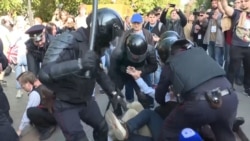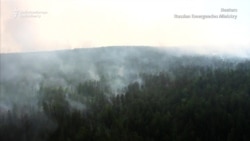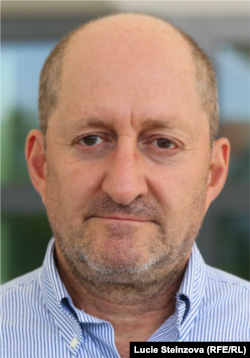To receive Steve Gutterman's Week In Russia each week via e-mail, subscribe by clicking here. The Week In Russia will not appear for the next three weeks. It will return on September 13.
Russia has endured deadlier and more momentous developments in August in the past, but not always so many of them. Amid massive wildfires, weekly protests whose size has grown, and a mysterious blast that killed five nuclear specialists, the Kremlin seems to be working hard to look unruffled.
Here are some of the key developments in Russia over the past week and some of the takeaways going forward.
The August Curse
In Russia this month, there has been no catastrophe comparable to "August events" of the past: an attempted coup that changed history, apartment buildings destroyed by bombs, and 118 submariners dead in the sinking of the Kursk.
But there has been a blast that killed five nuclear workers and apparently raised radiation levels, wildfires on territory about the size of Europe, and weekly protests – and weekly crackdowns – that have turned Moscow into a scene of mayhem every Saturday since July 27.
The Kremlin response so far? Nothing to see here.
In particular, the protests over decisions barring numerous independent candidates from the ballot in September 8 elections to the Moscow city legislature have been met with a studied Kremlin shrug whose exaggerated size seems to be in direct proportion to the attention the violent police response has been getting in Russia and abroad.
More than 2,500 people have been detained in connection with the demonstrations in Moscow on the past three Saturdays, including nearly 1,400 on August 3 – an unprecedented number in the post-Soviet history of the capital. Many have been beaten, and several have been jailed on riot-related charges that could put them in prison for years, despite the peaceful nature of the protests.
President Vladimir Putin has not commented on the protests or the actions of the police – and his spokesman suggested there’s no need for him to do so, saying that what’s been happening a few hundred meters from the Kremlin falls short of a political crisis and is, in fact, “nothing special.”
Without words, Putin seemed to suggest as much with the activities he chose to pursue on two of the biggest days of protest and crackdown. But if that was the intended signal, both of Putin's Saturday outings misfired in the eyes of critics who saw them as measures -- both metaphorical and real -- of his distance from the people.
On July 27, a day on which more than 1,300 people were detained in Moscow – some of them protesters, others bystanders – Putin sat in a glass-bubbled submersible that dived beneath the Baltic Sea to examine a submarine that sank in World War II.
To some observers, Putin pulled off a Bond villain look in the dive. Others were less impressed, suggesting he looked frightened or farcical.
Stunts And 'Shame'
Two weeks later, as more than 50,000 people demonstrated in Moscow – the biggest anti-government rally since a wave of protests in 2011-12 over alleged election fraud and his decision to return to the presidency after four years as prime minister – Putin attended a bike show in Crimea, the Ukrainian region Russia seized in 2014, organized by a motorcycle club that backs him.
A leather-clad Putin, 66, whom state media showed rolling in on a motorcycle equipped with a Russian flag, praised the Night Wolves club for showing people “how one should treat Russia” and called its members “manly and cool guys [who] set an example for the young people in our country.”
In Moscow, people with a large and proven following among young Russians were setting a different example by attending the protest.
One of them was YouTube star Yury Dud, who wrote on Instagram that in Russia today it is “shameful” – particularly for famous people – to profess political indifference.
Political apathy has led, he said, to a situation in which “there is no change in the highest offices,” which are always occupied by the same people – with their “gray hair, bald spots, jackets,” and unanimous votes that “increasingly resemble the decorations of Soviet so-called political life.”
“Our inertia has led to the annihilation of any political competition,” Dud added.
Putin’s own seemingly choreographed indifference was only part of the state response to the protests. Other pieces of the puzzle included what looked like a two-pronged propaganda offensive, with state and pro-Kremlin media painting the demonstrators as freakish fringe elements and the protests as a foreign plot.
And also praising the police and National Guard troops conducting the crackdown – as in these remarks by state TV host Vladimir Solovyov, who claimed to be speaking for “many millions of Russian citizens” when he voiced a “huge human thank you” to these forces.
“You are protecting the country. You are protecting the state.... You are protecting us from terror,” Solovyov said.
There may be many millions who disagree, however.
A recent poll found that 37 percent of Muscovites had a positive attitude toward the protests over the Moscow City Duma election and 30 percent were indifferent, while 27 percent had a negative view.
In any case, Peskov suggested that there was nothing strange about Putin staying mum on the protests.
Wildfires
“A huge amount of events happen in Russia every day that are, naturally, issues for the president’s attention. And it’s far from necessary for him to state his point of view on each and every one of them,” Peskov said on August 13.
One of the reasons a huge number of things happen every day is that Russia is huge. So big that the smoke cloud from wildfires raging in Siberia this summer was, at more than 5 million square kilometers, bigger than the European Union, the UN World Meteorological Organization said on August 11.
On the ground, meanwhile, Russia is on track for a record year in terms of the area covered by wildfires, Greenpeace said a day earlier.
This year’s Russian wildfires have attracted less attention than the blazes that burned in August 2010, which killed dozens of people -- with the estimated toll from the heat wave that fed them reaching about 56,000 -- and blanketed Moscow with toxic smog for many days.
Putin has not ignored the wildfires: A few weeks ago, he ordered the military to help put them out. But he used what the Kremlin said was an offer from U.S. President Donald Trump of aid in fighting the fires to suggest that Russia needs no such support from abroad -- while at the same time asserting that the phone call from Trump was a sign that tattered ties might be mended.
Putin expressed his gratitude and told Trump he would accept the offer of help if the situation demanded it. Translation: Thanks, but no thanks. We’ve got this.
When the White House statement came out, though, it made no reference to any offer of help, saying only that Trump “expressed concern over the vast wildfires afflicting Siberia.”
If the Kremlin’s approach to the Moscow protests has been “nothing to see here,” its tack in the wake of a mysterious and deadly blast at a test range on the White Sea was perhaps closer to “nothing we’ll let you see here.”
Radiation Spike
A week after the Defense Ministry said that an explosion and fire at a military unit in the Arkhangelsk region killed two people and injured six, little is clear about an incident that appears to have led to a spike in radiation levels nearby.
That includes the death toll, which is murky because the state nuclear agency Rosatom later announced that five of its employees were killed but did not specify whether they were separate from the two deaths reported by the military.
It also includes the specific cause of the blast and what exactly exploded, with some signs pointing to a nuclear-powered cruise missile touted by Putin, but others suggesting it could have been something else.
There was a lot of back and forth: Reports of an on-again, off-again evacuation of the town of Nyonoksa, and a statement about a radiation spike that was removed from the website of the city of Severodvinsk – only to be confirmed by Russia’s weather forecasting agency.
What is clear, at least to Kremlin critics, is that 33 years after Chernobyl – and amid a revival of interest in that accident due to the TV series with the same name – Moscow is still trying to keep potentially vital information about such incidents under wraps.
In an editorial on August 12, The New York Times said that “the pathetic, inchoate evasiveness of Russian authorities proved once again that the Kremlin is far more concerned with covering its behind than telling its people or the world what happened and how great the risk it carried.”











